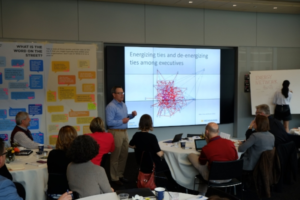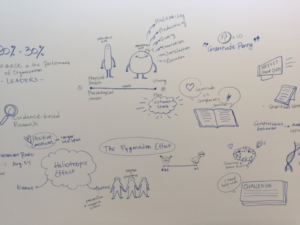
Positive Workplace Design: A New Toolkit for Organizational Performance
Can workplace design support thriving at work, bring out the best in people, and help nurture positive organizational change? If so, what are the scalable tools that help make this happen? These are questions that brought people together at the recent Thriving Workplace Summit, which was held at the University of Michigan’s Stephen M. Ross School of Business.
HLW, the university’s Center for Positive Organizations, and Colliers International co-organized this 1-day summit, which assembled a diverse mix of people from different professions, industries, and skill-sets in exploring these and other related questions.
Everyone at the table shared a passion for creating positive workplace experiences in their workplace. The summit purposefully bridged the disciplines of architecture and design practice, architectural technology, organizational research, and sociology in order to facilitate inter-disciplinary peer-to-peer learning while co-creating a new framework for positive workplace design.
What are the Attributes to Thriving Workplace?
The summit opened with an introduction to positive organizational scholarship – a school of thought that uses research and practice to reframe organizational actions in ways that enable leaders to cultivate a state of abundance in everyday practice, even in the face of everyday challenges and conflicts. Participants were then introduced to the concept of thriving, what it means in practice, and how it is measured and tracked at the individual and organizational levels. Later, the discussions turned to the topic of outcome measures that stem from practices that fill abundance gaps in organizational systems
Mapping the Social and Spatial Dynamics of Organizations
On the spatial side, the summit introduced participants to the concept of network mapping a way to understand the dynamic nature of social relationships and the attributes that can be measured within them – such as generosity, energy, and leadership qualities. Spatial analysis tools were then demonstrated, which allows for the tracking and measuring of network relationships in space.
Collectively, the organizational and socio-spatial tools and concepts framed key approaches for identifying the attributes of positive organizational performance, linking those attributes to leadership strategies, and understanding how to identify and map those attributes in broader organizational networks.

Using Positive Language to Reframe Organizational and Planning Challenges
In working with clients on a range of workplace engagements, we have found that one of the most common barriers to change is not having the right language to discuss challenges and opportunities across groups with different perspectives. In those instances, we have discovered the power of simple tools that use language and imagery in creative ways to help people gain a different perspective.
Similarly, this summit used imagery and language to introduce participants to new ways of addressing their own organizational and planning priorities. We developed a “reframe deck” that we used as part of an interactive session during the summit. The reframe deck helped participants alternatively define their questions using the tenets of the positive organization school of thought. Participants worked in teams and used the reframe deck to work through several problem statements that they defined in other mini exercises throughout the day.

Next Steps
Throughout the planning and delivery of the summit, we assumed that this would serve as a first iteration of what promises to be a series of gatherings around this topic. Participants were not quick to leave when the summit came to a close. Instead, many participants carried the conversation to the local beer garden near campus to discuss next steps and ideas for piloting some of the summit’s lessons. Some ideas that are in the works include:
- Spatial analysis tools to help compare and score space plans and layouts based on positive workplace design metrics
- Spatial analysis tools that measure the impact of layout and design on innovation outcomes (spoiler alert: research presented at the summit made the connection between space and innovation; others expressed a desire to measure it in their own organizations)
- Social network analysis as a way to strategically plan for individual and team adjacencies in workplace design
- A refined space utilization tool that measures the quality, not just the quantity of social, inter-personal interactions in the workplace – as a way to inform more robust principles purposeful space planning and design
- Tools that identify “energizers” who positively influence others and who serve as agents of positive change
- A platform to encourage more acts of gratitude within organizations as a way to create more goodwill among people and as a way to show people how their actions reinforce organizational values and goals
We’d like to thank the various companies whose people participated in the summit and made it the success that it was. Specifically, we’d like to thank the Blackstone Group, Bluewater Technology, DTE Energy, Duo Security, Ford Motor Company, Global Atlantic Financial Group, Google, Masco Corporation, Toyota, and Vectorform for the ideas that were brought to the discussion.


Authors: Pete Bacevice, Liz Burow, Jinghang Huang, and Lee Devore





